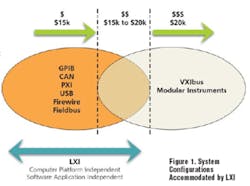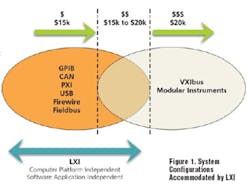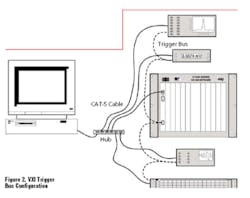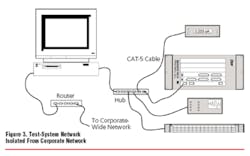A new instrumentation interface based on Ethernet could be poised to replace GPIB.
The functional test and data acquisition community has been instrumental in developing many industry standards ranging from the definition of communications interfaces to instrumentation backplanes. These functional requirements often are tightly coupled to and have evolved from the application space that they serve. Applications may range from small systems to medium-sized combinational systems to high channel-count, highly integrated implementations.
GPIB is an example of an instrumentation interface that has addressed small systems and some aspects of medium-sized combinational systems; VXI-based systems have dominated the high channel-count application market. However, GPIB now is being challenged by the need for ever-increasing bandwidth and higher data transfer rates. Many other standards have been advertised as the next-generation replacement for GPIB, such as the universal serial bus (USB), Firewire, CAN bus, PCI, and PXI, but none of these have met with wide industry acceptance.
Agilent Technologies and VXI Technology have joined forces to define a new instrumentation interface: LAN eXtensions for Instrumentation (LXI�). LXI is based on industry-standard Ethernet technology and will provide the flexibility and performance to small and medium-size systems that are commonplace on larger VXI systems (Figure 1).
Ethernet: The Logical Choice
By far, Ethernet is the most widely accepted communications interface in use today. Nearly every computer is manufactured with an integrated Ethernet interface, and networking hardware is becoming increasingly inexpensive. Many of the attributes that have made Ethernet so popular in the computer industry also are attractive to the instrumentation community.
Technical advantages such as transmission control protocol/Internet protocol (TCP/IP) error checking and fault detection as well as long inter-device connectivity exceed the limitations of parallel bus and other serial-based interfaces. The TCP/IP stack provides error detection and correction that typically will not interfere with throughput rates, especially when a dedicated test-system network is used. Furthermore, Ethernet connections can span 100 meters point-to-point; encompass 200 meters with the use of a hub, switch, or router; or extend to thousands of kilometers if fiber interfaces are used.
Before Ethernet-based devices can be accepted as the next generation of modular instruments, several instrumentation-specific requirements must be addressed, including:� Cooling
� Triggering
� Interrupt Handling
� Mechanical Interfaces
� Multiple Device Synchronization
� Software Interfaces
� Network Routing and Switching
� EMI/RFI
Some of these performance areas such as mechanical interfacing and cooling, while important, do not represent significant technical challenges. The most challenging aspects of LXI implementation involve instrument synchronization and timing, test-network architecture, and software interoperability.
LXI Device Synchronization
The first area of concern is device synchronization. The synchronization and control of multiple instruments are prerequisites for most functional test and data acquisition applications that depend on phase relationships or stimulus/response handshaking. Several approaches can be used to synchronize Ethernet interfaces, the most common including an auxiliary trigger subsystem (Trigger Bus), Network Time Protocol (NTP), or IEEE 1588.
An auxiliary trigger subsystem can provide extremely precise timing and control signals to multiple instruments with minimum phase skew. The Trigger Bus interface incorporates line drivers and twisted-pair cabling to ensure signal integrity and maximize transmission distances. Standard implementations will include bidirectional triggering capability and support both star and daisy-chain configurations. This provides the means to trigger and synchronize LXI instruments as well as other standard platform architectures such as VXIbus (Figure 2).
Another approach unique to Ethernet-based interfaces and inherent in LXI is the NTP, the current de-facto standard for network time synchronization. This approach is designed to synchronize the clocks of computers connected to a network; however, it only offers synchronization in the millisecond range.
NTP uses a reference clock that defines the true time, and the other devices are set to this source. Features such as fault tolerance and scalability make NTP a logical choice for most networked computers; however, it may not provide the performance needed for phase-critical data acquisition and control applications.
Many factors can affect the actual precision of NTP including network traffic, switches, routers, and distances between devices. This approach, however, can provide a reasonable level of synchronization and may be acceptable for slow and steady state measurements such as thermocouples and some pressure and strain devices.
The most accurate Ethernet-based timing is available through IEEE 1588, referred to as Precision Time Protocol (PTP). PTP defines a precision clock synchronization protocol for networked measurement and control systems. The protocol is designed to synchronize systems that include clocks of different precision, resolution, and stability. Submicrosecond accuracy can be achieved with minimal network and local clock computing resources and with little administrative attention from the user.
There are several ways in which PTP can be implemented, ranging from user-level software control to kernel-level driver modifications to hardware implementations using dedicated field-programmable gate arrays. User and kernel-level modifications, while outperforming NTP, still will be limited by other operating-system processes. Incorporating PTP in the standard will provide LXI with a level of synchronization that addresses many typical multiple instrument installations without the need for additional cabling or clock distribution systems.
The highest level of precision is obtained when hardware implementations assist in time-stamping incoming and outgoing network packets or frames. Delay fluctuations can be in the nanosecond range with this approach.
Test and Measurement LAN Implementations
Selecting the right network topology also is a concern and can have a significant impact on the overall performance and timing of Ethernet-based instrumentation. Ethernet networks function by sending packets of data between different nodes on the network. If two nodes transmit data at the same time, a collision will occur that affects system throughput.
Consequently, more collisions will occur as the number of nodes and network activity increases, resulting in a reduction in data throughput. As a result, the performance of an LXI-based instrumentation network will be improved if it is isolated from the general-purpose corporate network.
Dedicated networks are inexpensive to install and provide the necessary isolation between corporate-wide network traffic and the test system (Figure 3). Additionally, this network can be easily interfaced with the rest of the corporation or the World Wide Web with little effort.
Isolated instrumentation networks also eliminate many of the logistical issues that may arise when trying to conform to corporate network requirements. Security concerns also can be addressed by simply not allowing physical access to outside network connections.
Software and Programming
The final implementation issue involves software drivers and programming interfaces. Well-planned network topologies and synchronization schemes still depend on software drivers and programming interfaces if multivendor interoperability and operating-system independence are to be assured. The very nature of Ethernet and LXI-based instrumentation implies that many different configurations can be implemented using hardware from different instrumentation, computer, switching, router, and computer-interface hardware manufacturers.
Using a standard application programming interface (API) greatly reduces program development and software maintenance costs. Application programs then can be written in any standard language, such as C/C++, Visual Basic, LabVIEW, or VEE, all with the same familiar interface.
Summary
The successful adoption of any standard requires more than simply articulating technical merits. It includes dedicated real-world implementation teams identifying potential issues and ensuring complete functionality. The LXI standard will provide the basis for long life-cycle instrumentation implementations that are not limited by bandwidth, software, or computer-dependent architectures.
About the Author
Jon N. Semancik joined VXI Technology in 2002 and currently is the company�s marketing and business development manager. The U.S. Navy veteran has held engineering and project management positions on numerous programs in both the military and commercial sector. Mr. Semancik earned a B.S.E.E. from Fenn College of Engineering and an M.B.A. from the Weatherhead School of Management, Case Western Reserve University. VXI Technology, 2031 Main St., Irvine, CA 92614, 949-955-1894, e-mail: [email protected]
October 2004




